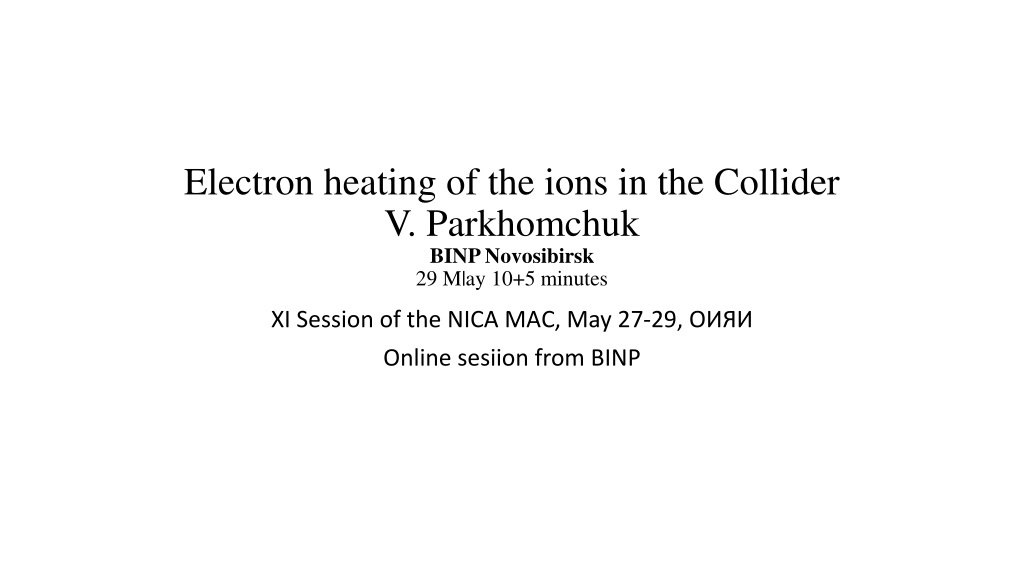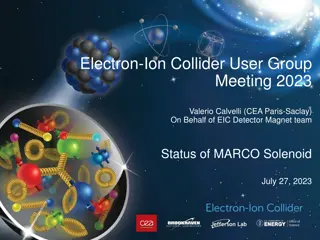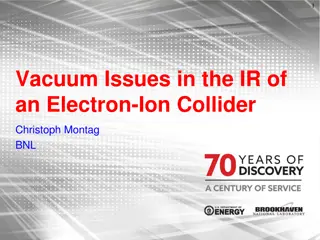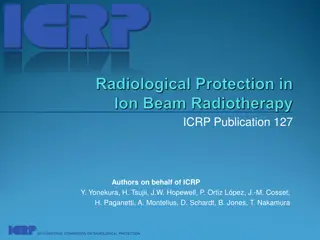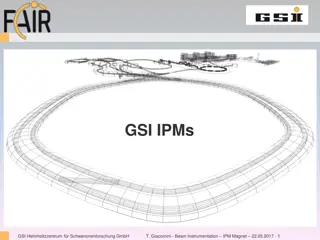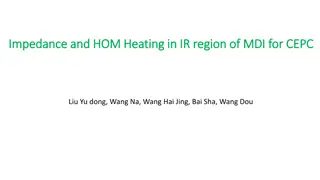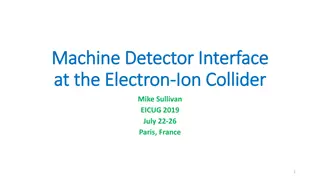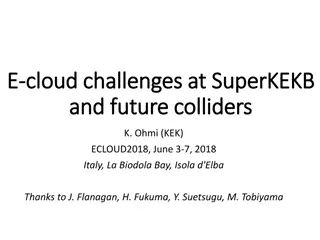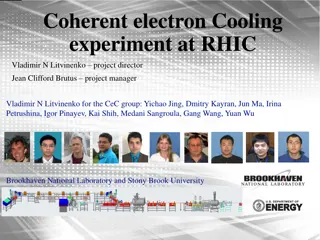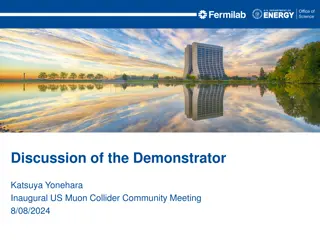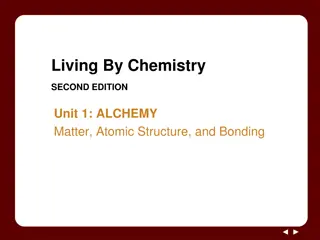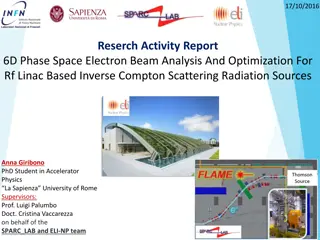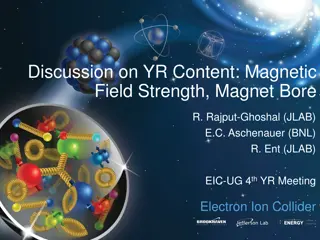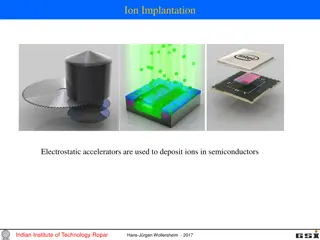Ion Beam Intensity Enhancement Through Electron Heating in Collider Experiments
The study discusses electron heating of ions in collider experiments at the Collider V. ParkhomchukBINP facility in Novosibirsk. It explores the effects of electron cooling on ion beams, ion beam oscillations, losses, and ion beam intensity enhancement. Various factors such as ion charge, classical radius, cooling mechanisms, beam currents, and energy modulations are analyzed to optimize ion beam performance. Experimental results and theoretical calculations provide insights into maximizing ion beam intensity through effective electron heating strategies.
Download Presentation

Please find below an Image/Link to download the presentation.
The content on the website is provided AS IS for your information and personal use only. It may not be sold, licensed, or shared on other websites without obtaining consent from the author. Download presentation by click this link. If you encounter any issues during the download, it is possible that the publisher has removed the file from their server.
E N D
Presentation Transcript
Electron heating of the ions in the Collider V. Parkhomchuk BINP Novosibirsk 29 M|ay 10+5 minutes XI Session of the NICA MAC, May 27-29, Online sesiion from BINP
??=(???)2 ???2 eZi-charge of ion Laslet tune shift Classical radius N r R = i i emitance ?? R average radius of collider bunch length 2 3 l b COSY 200 MeV proton beam 10 10 Electron heating- High initial intensity- fast losses, proton beam current afte start electron cooling From 0.73 go to 0.25 mA! 100-300 s- Laslet tunr near 0.1-0.2, equilibrium t>300 s Intra Beam Scatering i r dt p 8 Cj 1 Cj 2 6 Cj 3 10 Cj 4 100 4 2 2 4 1 N cLn dp = i c 2 2 0 3 2 / 3 2 / 1 2 0 0 0 100 200 300 400 500 600 0 Cj 0 551 time sec horizontal sigma /1mm vertical sigma /1mm proton beam current /(0.1mA) electron beam current /100mA Fig 1. COSY low energy (200 MeV) proton beam cooling current (0.2A)
6 34+ current Kr signal pickup electrodes Fig.2 SIS-18 accumulation krypton ion beam After 2 mA started oscillations at ion beam end acculamution decreseed, after 5 mA stopped- As results high losses between new injection are equal adding new portion ions. ion beam current (mA) 4 2 0 10 20 30 40 time (s)
0,010 no modulation 200 V modulation 300 V modulation CELSIUS (1999) 400 MeV pbeam Je=600 mA beam current no modulation beam current 300 V modulation electron energy pbeam r.m.s. size (mm) pbeam r.m.s. size (mm) with 300 V modulation losses rate dI/dt/I (1/s) 8 0,005 7 Proton beam current (mA) 6 5 4 0,000 0 1 2 3 4 5 6 3 proton beam current (mA) Fig.4 Losses rate versus proton beam carrent dI/dt/I (Ep=400 , Jecooling=600ma). for different energy modulation 0,200,300 V 2 1 0 -1 0 50 100 150 time (s) Fig 3. Acselleration and them electron cooling proton beam with energy 400 MeV, proton beam with energy 400 MeV. The top lines show proton beam current mA (black without modulation of the energy electron beam red line with 300 V modulation of energy (potential cathode)) The down lines proton beam sizes mm (sigma,x,y),
Maximum ion beam intensity with electron cooling n Z e F eff 2 4 ) / ln( 4 V mV eff n Z e dt 4 2 4 ln( / ) = max min V i e 3 Cooling force mV n e where me is the electron mass, c is the speed of light, re is the classical radius of the electron, ne is the electron beam density , ln ( max min) is the Coulomb logarithm of collisions. Electrons passing by particles scatter on it and lead to the heating of its momentum at a speed e Z Losses energy the ion by excitation electrons moving (cooling) = 2 max min FV i 3 4 2 2 4 ln( / ) dp = Heating from thermal mooving electrons max min i e V eff m In equilibrium temperatures are equal But heavy ions moved very slowly V = 2 2 eV eff M For high the ion beam density at interaction regions many fluctuation from other ions 4 N = * 3 max in 3 Heating from others ions should be less electron cooling M 2 ( F 2 ) * N FV
6 = 2 2 4 2 i 2 e 4 4 rc r n 4 c r n 1 i i e e ln( / ) max min 4 6 6 1 . 1 17 6 10 / 1 ( ) n n cm ilab elab 4 cool 2 4 ( ) ln( / ) l r r min i e 4.6 GeV/n Ni<8E10 0.5 GeV/n Ni<5E8 beam-plasma instability, beam instability, or bump-on- tail instability
Plasma model of instability proton and electron beam position (cm) 140 proton electron 1,0 120 interaction at zone +-125 cm 100 electic field (V/cm) 80 60 0,5 40 20 0 -20 0,0 -40 -300 -200 -100 0 100 200 300 -200 -100 0 100 200 position along cooling section (cm) position along cooling section (cm) Slowly moved ion and electrons fast compensated return electric field for ion plasma oscilation. It means the mplitude Of oscillation can increase.
Increasing space charge oscilation after passing cooling section Det(A) <1 cooling, Det(A)>1 heating
CONCLUSION 1- Electron cloud effects are problems for electron positron collider. Small solenoids in collider help control this effect 2- Ion beams with electron cooling system should care for limited heating 3- Hollow electron beam are one of the ways for decreasing unlikely interaction
